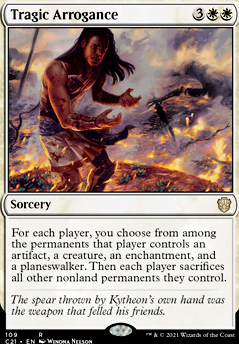Land (36)
-
1x
Arch of Orazca

-
1x
Arid Mesa

-
1x
Emeria, the Sky Ruin

-
1x
Evolving Wilds

-
1x
Flooded Strand

-
1x
Inkmoth Nexus

-
1x
Marsh Flats

-
1x
Maze of Ith

-
1x
Mikokoro, Center of the Sea

-
1x
Miren, the Moaning Well

-
1x
Mistveil Plains

-
1x
New Benalia

-
15x
Plains

-
1x
Reliquary Tower

-
1x
Strip Mine

-
1x
Terrain Generator

-
1x
Terramorphic Expanse

-
1x
Thawing Glaciers

-
1x
Tower of the Magistrate

-
1x
Vesuva

-
1x
Wasteland

-
1x
Windswept Heath

Enchantment (11)
Sorcery (15)
-
1x
Akroma's Vengeance

-
1x
All is Dust

-
1x
Armageddon

-
1x
Austere Command

-
1x
Balancing Act

-
1x
Cataclysm

-
1x
Descend upon the Sinful

-
1x
Hallowed Burial

-
1x
Idyllic Tutor

-
1x
Planar Cleansing

-
1x
Rout

-
1x
Slaughter the Strong

-
1x
Terminus

-
1x
Tragic Arrogance

-
1x
Wrath of God

Creature (13)
-
1x
Academy Rector

- 1x Alms Collector
- 1x Angel of the Dire Hour
-
1x
Emeria Shepherd

-
1x
Eternal Dragon

-
1x
Linvala, Keeper of Silence

-
1x
Resolute Archangel

-
1x
Solemn Simulacrum

-
1x
Stonecloaker

-
1x
Stoneforge Mystic

-
1x
Sun Titan

-
1x
Ulamog, the Infinite Gyre

-
1x
Weathered Wayfarer

Planeswalker (3)
Commander (1)
Artifact (15)
-
1x
Batterskull

-
1x
Caged Sun

-
1x
Crucible of Worlds

-
1x
Extraplanar Lens

-
1x
Gauntlet of Power

-
1x
MImic Vat

-
1x
Mind's Eye

-
1x
Rings of Brighthearth

-
1x
Scroll Rack

-
1x
Sensei's Divining Top

-
1x
Skullclamp

-
1x
Sol Ring

-
1x
Sword of Feast and Famine

-
1x
Sword of Fire and Ice

-
1x
Sword of Light and Shadow

Instant (6)
Suggestions
Updates Add
Comments
Attention! Complete Comment Tutorial! This annoying message will go away once you do!
Important! Formatting tips — Comment Tutorial — markdown syntax
Please login to comment
| Date added | 7 years |
| Last updated | 5 years |
| Exclude colors | UBRG |
| Legality | This deck is Commander / EDH legal. |
| Rarity (main - side) | 18 - 0 Mythic Rares 56 - 0 Rares 8 - 0 Uncommons 3 - 0 Commons |
| Cards | 100 |
| Avg. CMC | 4.02 |
| Tokens | Angel 4/4 W, Angel 4/4 W w/ Vigilance, City's Blessing, Copy Clone, Emblem Elspeth, Knight-Errant, Emblem Elspeth, Sun's Champion, Pegasus 1/1 W, Phyrexian Germ 0/0 B, Soldier 1/1 W, Soldier 1/1 W w/ Lifelink |
| Folders | Eight and a Half Tails, cEDH - Competitive Casual & cEDH, edh, EDH, Casual, I like!, Decks To Work Towards, EDH, EDH Decklsits, edh |
| Votes | |
| Ignored suggestions | |
| Shared with | |
| Views |


